Want to know what moments have the power to shape employee experience? You’d be surprised: it can be the tiniest thing throughout their tenure with your company. From application and onboarding to performance reviews and vacations, there are a lot of opportunities to impress — and even more to disappoint.
An end-to-end staff member journey can drag out for months or even years. Unsure of where to start mapping the milestones along that winding road? Look no further. Whenever you feel stuck looking at a blank map canvas, need inspiration, or crave food for thought, our deck of cheat cards is here to help you with journey mapping for employees.
Fresh off the shelf, the cards come as a PDF file, as colorful and insightful as ever. Download them for free, and then print them out or use in the digital format, whichever is more convenient. Each card can be a conversation starter, bringing you back to the core goal of the exercise: finding areas to improve the employee experience.
What’s inside
The digital deck is 69 pages long. It contains a short introduction, followed by two different types of one-sided cards:
1. Employee journey stages: 7 major groups, about 4–8 substages long. Each card has a name, an illustration, and a prompt. For some cards, the latter comes in the form of a thought-provoking question.
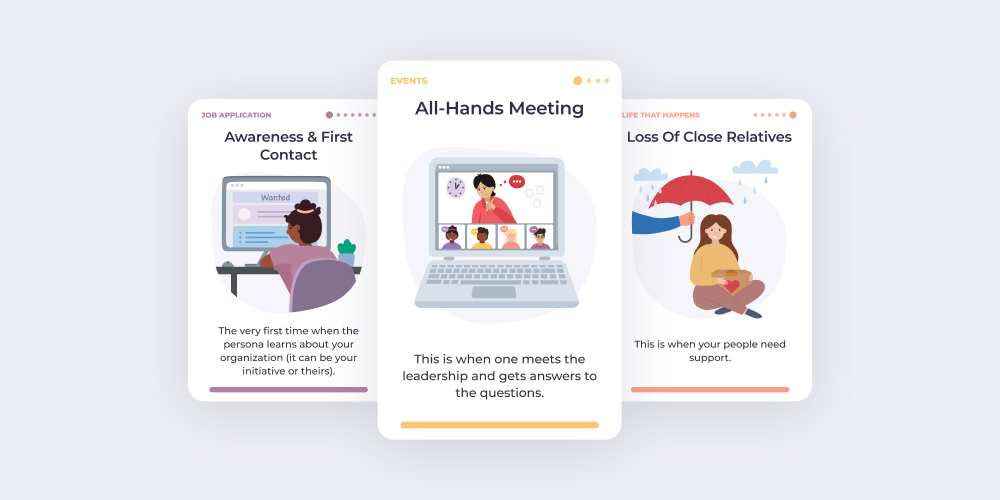
Stage cards represent the typical stages or substages of an employee’s journey. In the top left corner of each card, you’ll see its main category:
- Job application;
- Onboarding;
- Work;
- Grow;
- Events;
- Life that happens;
- Leave.
Color-coding will help you identify what category the card belongs to. For instance, blue stands for Work, red is for Leave, and yellow is for Events. Look at the color line at the bottom of each card to quickly tell apart or group them when journey mapping for employees.
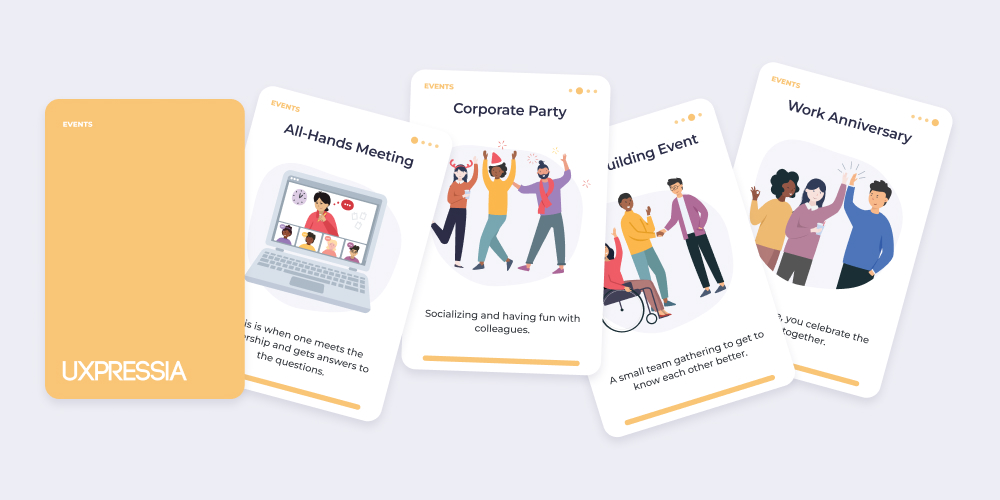
2. Journey map layers for the common sections your map could have.
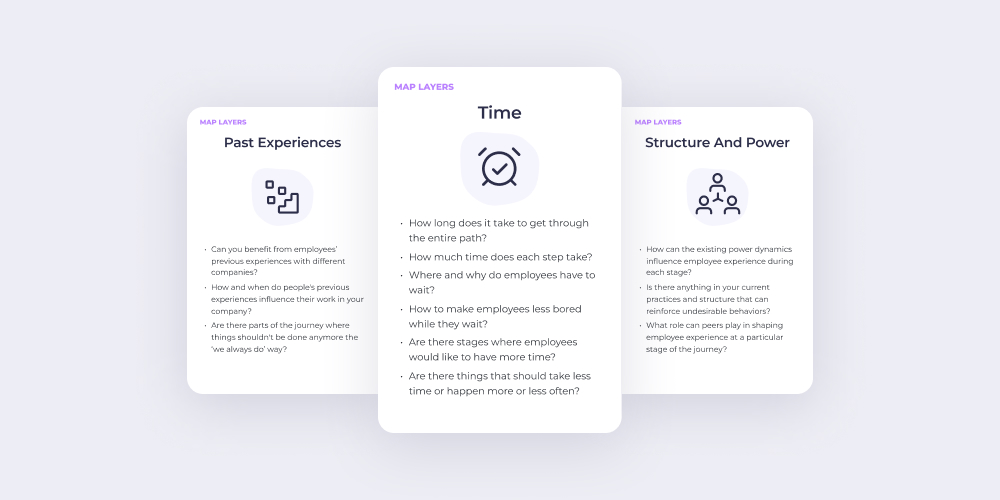
Layer cards apply to all stages of the journey. They contain a set of framing questions, or, sometimes, suggestions, of what aspects of the journey you could consider and unfold. For example, a card called ‘Company goals’ asks you to think of concrete goals and values that are important to the business. There’s also one for ‘Questions’, ‘Quotes’, ‘Channels’, and so on.
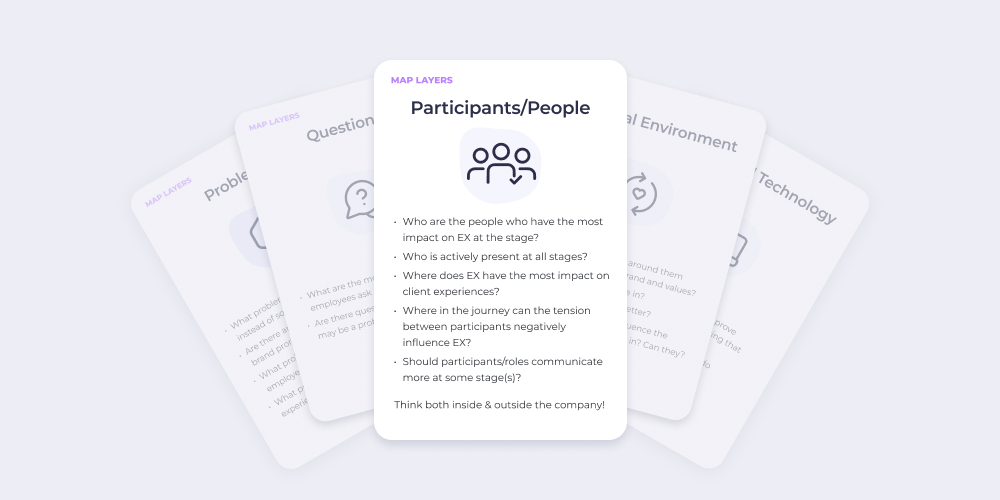
Finally, you can arrange the cards from two groups to form the structure of a journey map, with layers (L) for rows and stages (S) for columns:
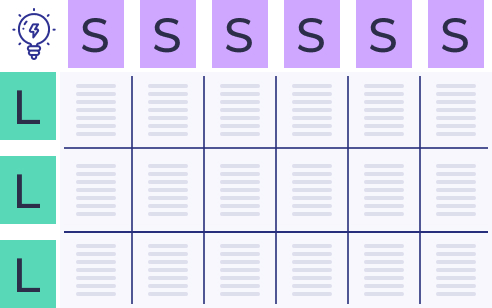
The placement of the stage cards, from left to right, should follow the chronological order of the employee journey, while layers may be arranged at random.
How to use cards to aid journey mapping for employees
The good news is that there is no right or wrong way to use the deck:
- Bring it to team workshops or set it aside for individual brainstorming sessions;
- Map an as-is or a to-be journey using the stages and layers from the cards;
- Randomly pick a single card to focus on, or go through all of them one by one;
- Create a journey map from scratch or rethink a map you’ve already built;
- Keep the deck as a digital document, or print it and cut it into separate physical cards.
Whatever works best for your creative process.
If you’re building a new map, it makes sense to start with the stage cards first. Select the ones you feel are right for the scope and goal of your current project, or use the whole deck for an end-to-end journey. Work out a sequence in each consecutive category. Then use the layer cards to contemplate what happens during each stage and identify the moments that require the most attention.
For example, a business wants to focus solely on its onboarding process, as many employees leave after the probation period. Then it would make sense to use only the 6 cards from the blue ‘Onboarding’ category.
Say, you’ve picked the stage called ‘Paperwork’ and a layer card labeled ‘Time’. Answering the questions from the card in the onboarding context will highlight the weak spots in the journey. Card by card, you’ll have a list of experience problems. And once the issues have surfaced, start working towards solutions.
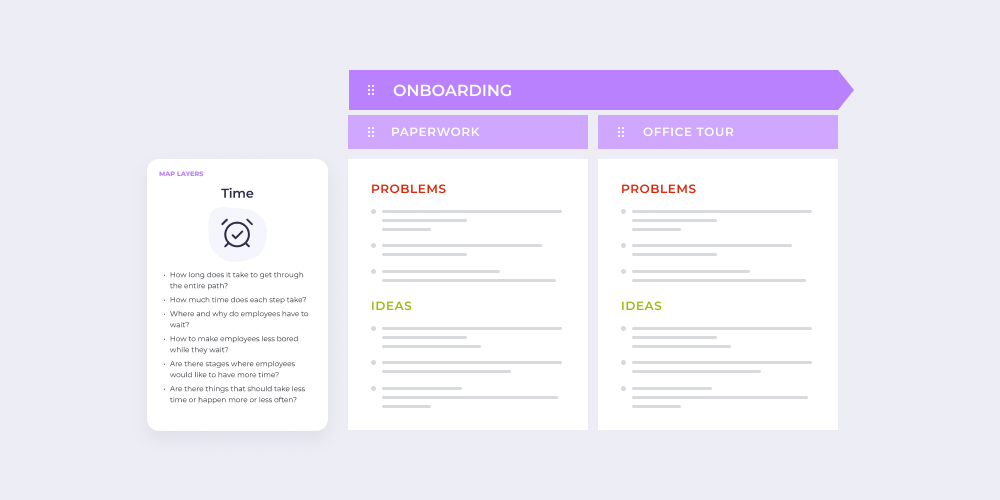
Alternatively, for a map that’s already created and needs a refreshment, you might start by taking the layer cards and examining each current stage further. Once you’re done, look through the stage cards and consider adding some substages that aren’t covered in the map.
For instance, you’re trying to assess how your company supports employees in their everyday life and already described the parental leave, sick days, and retirement. From the cards in the ‘Life that happens’ category, you can also see that you might need to examine personal events like birthdays and a loss of close relatives.
The deck will save you time and effort as it lets you channel all your energy into contemplating the employee journey instead of worrying about the technical aspects of putting it together.
Final words
There are numerous steps that a staff member goes through during their time with your company, related both to their work and personal life. Journey mapping for employees requires you to look at their experience from different scopes and angles. To create a comprehensive, true-to-life map, you’ll need to keep a variety of stages and layers in mind. That’s exactly what our deck of cheat cards can help you with.
And by improving the experience of your employees, you empower them to take the same approach with your customers.
Get the deck:






Personally, I find working on EX even more challenging than CX sometimes. Customers are happy to share their frustrations, but employees may keep quiet until they have a different job lined up and are already handing in their resignation. And even then, most people want to part on good terms and won’t share the negative parts of the experience.
So I hope this deck will give us a broader view on what questions to ask and issues to look into while journey mapping for employees. Cheers!